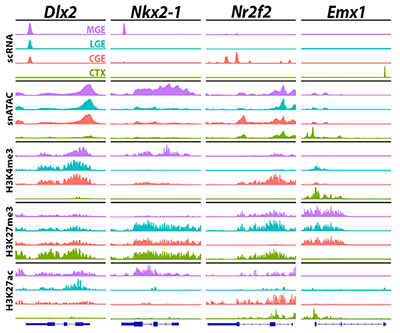
A graph from the study showing the chromatin landscape in the forebrain.
Credit: Petros Lab, NICHD
Learning how different neurons form and mature during early embryonic development provides foundational knowledge for understanding the brain and how neurological diseases arise.
Researchers from the Petros Lab and the Rocha Lab developed a new resource that captures changes in the chromatin landscape as neuronal progenitor cells develop into GABAergic neurons in the mouse forebrain. During embryonic development, transient structures called the medial, caudal, and lateral ganglionic eminences (MGE, CGE, and LGE) give rise to all GABAergic cells in the forebrain. The study team obtained neural progenitor cells from these three regions, as well as the cortex, and performed a series of cutting-edge techniques to assess the chromatin landscape in these regions. One method, called single nuclei ATAC-Seq, measures chromatin accessibility, which refers to open regions of DNA throughout the genome indicative of gene activation. The team identified thousands of accessible peaks, many restricted to distinct progenitor cell types or brain regions. They also integrated this data with other methods to characterize changes in histone modifications and higher order chromatin structure to generate insights into important DNA sites called enhancers and promoters.
The dataset represents the most comprehensive analysis of the chromatin landscape in the developing brain to date. It characterizes the variation and spatial specificity of mRNA, gene accessibility profiles and active enhancers during neuron development and across different neuronal cell types. The data are available online and serve as an important resource for neuroscientists.
Learn more about the Neurosciences Affinity Group: https://www.nichd.nih.gov/about/org/dir/affinity-groups/neurosciences.
Learn more about the Genetics and Epigenetics of Development Affinity Group:
https://www.nichd.nih.gov/about/org/dir/affinity-groups/GED.
Learn more about the NICHD Bioinformatics and Scientific Programming Core: https://www.nichd.nih.gov/about/org/dir/other-facilities/cores/bioinformatics.
 BACK TO TOP
BACK TO TOP